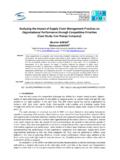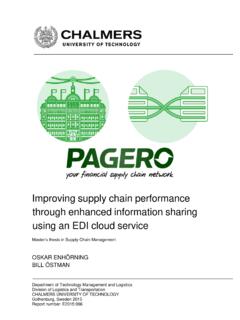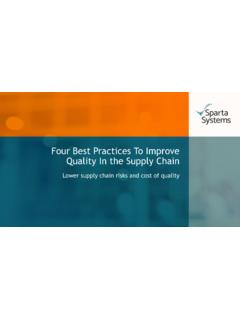Transcription of Helping Loblaw achieve high performance through Supply ...
1 Helping Loblaw achieve high performance through Supply chain transformation Client backgroundLoblaw Companies Limited is Canada s largest food retailer and a leading provider of drugstore, general merchandise, and financial products and services. through its portfolio of store formats, Loblaw is committed to providing its customers with a wide, growing and successful range of products and services to meet their everyday household demands. Loblaw operates more than 1,000 corporate and franchised stores, and employs more than 135,000 full-time and part-time employees. In 2012, Loblaw generated revenues of approximately CAD$32 billion (US$32 billion). Loblaw operates 30 distribution centers and runs the largest fleet of trucks in Canada.
2 Loblaw is constantly working to improve the efficiency of its Supply chain in an effort to ensure that the freshest products get to its customers, quickly and at the lowest challengeLike many industry leaders, Loblaw long has acknowledged that Supply chain management is an essential contributor to operational excellence. Yet, a convergence of factors from new competitive threats that made customer service more important than ever to limited historical investments in Supply chain practices and enabling technologies had made improving Supply chain performance an increasingly elusive goal. The retailer recognized that inadequacies within its existing Supply chain capabilities were taking a toll on its ability to effectively serve its customers and deliver value to shareholders.
3 Challenges were particularly pronounced in three key areas:Transportation. Loblaw s legacy transportation network was fragmented and managed on a regional basis, with few standardized processes and no common technology platform. Additionally, transportation planning activities were conducted independently at each of Loblaw s many distribution centers, meaning that inbound and outbound operations were rarely integrated and transport assets were not optimally utilized. Warehousing. As its sales volumes grew, so did the number of products that needed to be efficiently managed and distributed. This posed a challenge because the retailer s legacy distribution center network was supported by an aging infrastructure and comprised a fragmented collection of regional centers and outside storage facilities, which ran separate IT systems.
4 In addition, the network model was more focused on storing products than enabling their effective flow to consumers. This impeded the company s ability to provide superior product quality, availability and freshness. Forecasting and replenishment. Loblaw recognized the need to improve its demand planning capabilities and, specifically, its ability to accurately forecast product demand and replenish inventory in a timely and optimal manner. Under its former way of operating, Loblaw s inventory levels tended to be elevated, while its consumer shelf availability was lower than desired. This misalignment made it difficult for the retailer to maintain the service levels and product freshness its customers desired.
5 To maintain the company s position as a best-in-class retailer, address its operational cost pressures, and better meet its customers demands for product availability and freshness, Loblaw s leadership team knew that a complete Supply chain transformation was in order. Such a transformation would require investments in new Supply chain capabilities and enabling technologies, as well as an upgrade to the company s physical Supply chain infrastructure. Importantly, Loblaw wanted the transformation effort to achieve immediate benefits to quickly offset program investments and to help maintain stakeholder engagement and support. For support in designing, building and delivering the new flow Supply chain capabilities that would help Loblaw maintain its competitive position and serve as a platform for future growth and profitability, the retailer turned to Accenture.
6 Several factors influenced this decision, including Accenture s deep operational Supply chain capabilities, strong local team skills, and collaborative approach to delivering value and high performance . How Accenture helpedAccenture quickly assembled a global team of professionals with deep Supply chain and technology knowledge to work with Loblaw s business and Supply chain leaders to define the retailer s vision for its Supply chain . Loblaw and Accenture agreed that the transformed Supply chain capability needed to be national in scope, comprehensive in its functionality, and highly responsive to rapidly changing market conditions and customer demands.
7 It also needed to be based on a flow (as opposed to storage ) model that would make it possible for Loblaw to better ensure the quality, freshness and availability of its products. Given the critical nature of the change that was being undertaken, the team made sure the transformation program was underpinned by a robust business case, rigorous program management and governance structures, field tested approaches contained within the Accenture Delivery Methods, and ongoing cost/benefit analyses. And because it was important to generate immediate results, the team focused on implementing simple solutions, delivered in a fast, yet manageable, sequence.
8 Throughout the program, Accenture Supply chain professionals were embedded in the Loblaw business and worked hand-in-hand with client teams to facilitate the transfer of knowledge and insights, as well as to accurately understand the retailer s challenges, the solution requirements and how the transformation would affect all stakeholders. The joint team carried out the transformation in three key phases. During the first phase, solution design, Loblaw and Accenture identified core Supply chain business requirements and capabilities and designed the end-to-end processes needed to support the flow Supply chain vision. The solution design phase which was strongly influenced by customer and store needs addressed several Supply chain imperatives, including improved on-shelf availability, store- and shelf-ready shipping and packaging, quality and freshness, as well as balancing cost-to-serve.
9 In addition to designing the solution, the team developed a five-year transformational road map to keep the program on track. This roadmap not only aligned an aggressive deployment schedule to milestone events, but also balanced the delivery of new capabilities and systems with available resources and the retailer s capacity to absorb change. In the second phase of the transformation, capability delivery, the team implemented a deployment plan that was designed to enable Loblaw to begin slowly and then accelerate change through a crawl, walk, run model. Each step of the capability delivery plan built on the proficiencies and confidence gained in previous steps.
10 Specifically, the joint Loblaw and Accenture team delivered new capabilities in four areas: Super user transportation. Loblaw and Accenture streamlined and standardized a number of transportation management and operations processes and established four regional transport planning centers. In parallel, the team deployed the JDA Transport Management System to these new planning centers (and to all Loblaw distribution centers). To make sure that Loblaw would be able to generate the desired benefits from the new system and processes on an ongoing basis, the team established a super user program, which aimed to build deeper systems-related skills within Loblaw s transport operations.



















